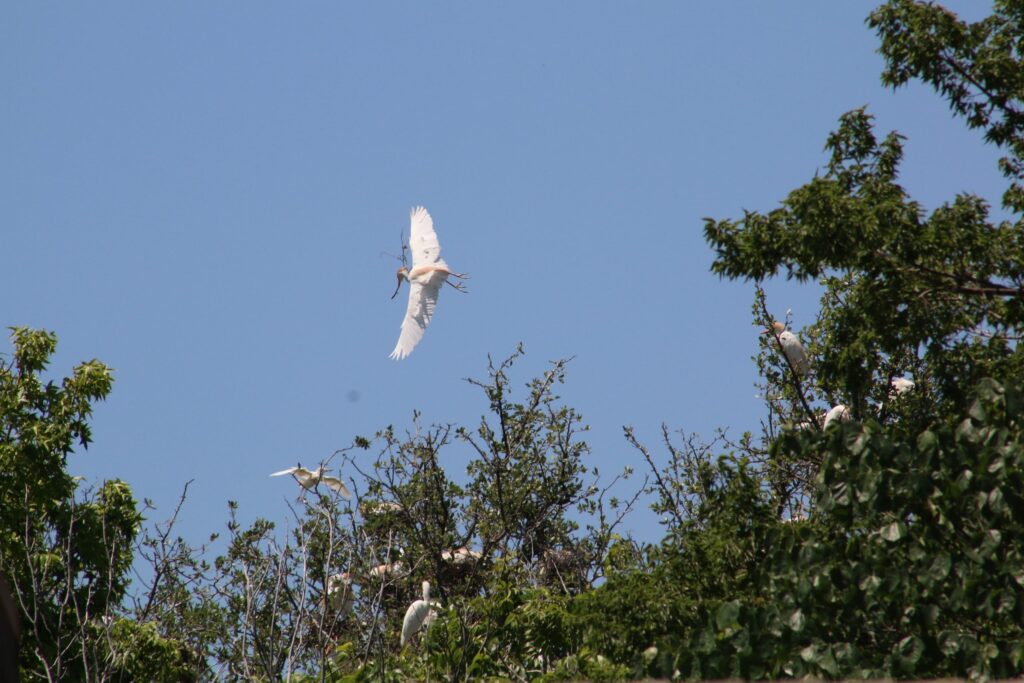As peak egret season nears its end in North Texas, city officials say they received more reports — and complaints — this year regarding egret and heron sightings in Fort Worth than the past two years.
As of data collected in May, Fort Worth Code Compliance officials received 72 calls from the public reporting egret sightings in 2025. That number is slightly up from 70 calls made in 2024 and 64 calls in 2023.
Fort Worth officials have not seen a significant change in egret and heron sightings compared to previous migratory seasons due to residents participating in measures to prevent nesting, said city spokesperson Brenda Matute in a statement.
With migration season typically beginning in February or March until June, egrets and herons have long prompted concerns and complaints from Fort Worth residents, primarily due to large amounts of excrement and feathers dropped by the migratory birds.
Of the many species, the cattle egret, the snowy egret, the great white egret, the little blue heron, the yellow-crowned night heron and the black-crowned night heron are most commonly seen in Fort Worth.

Matt Maxwell, who lives in the Candleridge neighborhood in southwest Fort Worth, has seen and experienced the damage caused by egrets.
Through the Candleridge Homeowners Association, Maxwell has assumed the responsibility of monitoring the birds for signs of “roosting,” when egrets build nests and breed, and locating more appropriate locations for nesting.
If caught in time, the birds are encouraged by Maxwell and his neighbors to move to other areas for nesting. Fort Worth leaders urge residents to take nonharmful, deterrent methods, such as tree trimming and using air horns, to keep egrets and herons from roosting. These methods are not designed to harm the birds but encourage them to nest and inhabit other areas, said Matute.
But once nesting begins, the birds develop “rookeries,” where egrets and herons hunker down in roosting yards and trees past their season to migrate, as late as October, through North America.
Nesting birds cannot be removed. The birds are protected by the Migratory Bird Treaty Act of 1918. Including four other countries, the act protects more than 1,100 species from being captured, killed, and traded or sold.
“They’re a very beautiful bird and we have no qualms for the bird seeking a place to have their offspring and so forth,” said Maxwell. “But you know it is a little strange that the federal government continues to protect (egrets) … given how robustly they have come back.”
After birds establish their rookeries, the damage to property and homes can “devastate” an entire neighborhood, said Maxwell. The problem is significant enough to have earned the attention of City Council members, including Charlie Lauersdorf who represents parts of north Fort Worth. He has directed resources to the Park Glen neighborhood.
He also encourages residents to comply with city officials if they observe staff removing nests.

“The city gets a permit to remove around 300 nests or so per calendar year and those are for the entire city,” said Lauersdorf in a social media post. “While we all appreciate our migratory birds, it’s important to remember that migrations of this size cause serious property damage.”
Maxwell told the Report federal officials should amend the treaty to accommodate both the animals and homeowners.
“I understand it is a multi-government treaty to protect these migratory birds, however, it may be time to revisit this treaty and their federal status,” said Maxwell.
Residents can report egret and heron activity to code compliance officials and find more information on the migratory birds here.
Nicole Lopez is the environment reporter for the Fort Worth Report. Contact her at [email protected].
At the Fort Worth Report, news decisions are made independently of our board members and financial supporters. Read more about our editorial independence policy here.
Related
Fort Worth Report is certified by the Journalism Trust Initiative for adhering to standards for ethical journalism.
Republish This Story
![]()


